
|
|
The Composer
Part II
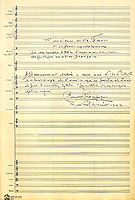 |
 Autograph manuscript of the "Chanson d'hiver" from Images du Canada français composed in 1943. Premiere on March 9, 1947 in Montréal by the Canadian Broadcasting Corporation Montreal Orchestra conducted by Jean-Marie Beaudet and the choir La Cantoria conducted by Victor Brault.
Autograph manuscript of the "Chanson d'hiver" from Images du Canada français composed in 1943. Premiere on March 9, 1947 in Montréal by the Canadian Broadcasting Corporation Montreal Orchestra conducted by Jean-Marie Beaudet and the choir La Cantoria conducted by Victor Brault. |
"The Images du Canada français for chorus and orchestra are a series of small acoustic etchings in a traditional style. They were written for the audience of "Matinées d'initiation à la musique," and their titles are: 'Le Gros Chat de grand'maman,' 'Chanson d'hiver,' 'Giboulée,' 'Les Petits Enfants,' and 'Marine' .... It is a type of suite, but one linked by intermezzos so that there is a unity. The lyrics of the first three songs were written by Dr. Adrien Plouffe. The last, 'Marine,' is inspired by a Canadian song derived from French folklore."
Claude Champagne, "Musique canadienne -- Nos compositeurs," radio broadcast series Les Heures musicales. CKAC in cooperation with the International Service of the Canadian Broadcasting Corporation, n.d., tape.
"Inspired upon my return from a trip to Percé by the visual and auditory impressions created by the imposing spectacle of the Gaspé region, I tried simply to transform the spectacle of the Gaspé into music ... I started developing this work in Gaspésia ..."
Claude Champagne, "Notice sur la Symphonie gaspésienne", n.d.
 |
 Allegretto from Gaspésia, written in 1944. Autograph manuscript. Premiere on November 4, 1944 in Montréal by the Montreal Philharmonic Orchestra conducted by Wilfrid Pelletier.
Allegretto from Gaspésia, written in 1944. Autograph manuscript. Premiere on November 4, 1944 in Montréal by the Montreal Philharmonic Orchestra conducted by Wilfrid Pelletier. |
"... and, after hearing Gaspésia ... it struck me as a kind of pastel, and that annoyed me, because I wanted to create an acoustic fresco; and that is why I began again with the same material, the same elements that I had developed, and I really did, [succeed] I think, [with] what I call the Symphonie gaspésienne".
Claude Champagne, "Musique canadienne - Nos compositeurs", radio broadcast series Les Heures musicales. CKAC in collaboration with the International Service of the Canadian Broadcasting Corporation, n.d., tape. n.d., tape. (1972 - 11/J2,12).
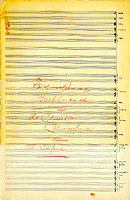 |
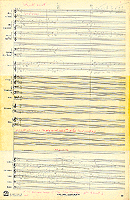 Allegretto
from the Symphonie gaspésienne, written in 1945. Autograph manuscript. Premiere on December 21, 1947 in Montréal by the Canadian Broadcasting Corporation's Montreal Orchestra conducted by Jean-Marie Beaudet. Ninth exchange program between the CBC and the Radiodiffusion française. Allegretto
from the Symphonie gaspésienne, written in 1945. Autograph manuscript. Premiere on December 21, 1947 in Montréal by the Canadian Broadcasting Corporation's Montreal Orchestra conducted by Jean-Marie Beaudet. Ninth exchange program between the CBC and the Radiodiffusion française. |
 Page of a general analysis of the Symphonie gaspésienne. Autograph manuscript, 1945. Page of a general analysis of the Symphonie gaspésienne. Autograph manuscript, 1945.
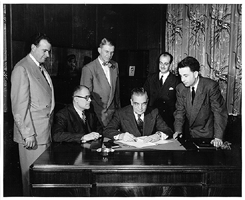 Photograph taken at the signing of the contract with the record company Polydor, for the international distribution of Claude Champagne's Symphonie gaspésienne. Seated (from left to right): Claude Champagne; Augustin Frigon, general manager of Radio-Canada. Standing (from left to right): Don Mekim from Quality Records, Polydor's Canadian representative; Charles R. Delafield, assistant to the director of Radio-Canada International; Gérard Arthur, director of Radio-Canada International's French Language Services; Jacques Canetti from Polydor. Photograph taken at the signing of the contract with the record company Polydor, for the international distribution of Claude Champagne's Symphonie gaspésienne. Seated (from left to right): Claude Champagne; Augustin Frigon, general manager of Radio-Canada. Standing (from left to right): Don Mekim from Quality Records, Polydor's Canadian representative; Charles R. Delafield, assistant to the director of Radio-Canada International; Gérard Arthur, director of Radio-Canada International's French Language Services; Jacques Canetti from Polydor.
[April 27, 1951], photographer: Salmon Studios.
 |
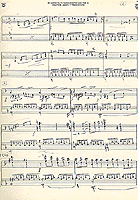 Sketch of the first movement of the Concerto for piano and
orchestra written between 1948 and 1950. Autograph manuscript.
Sketch of the first movement of the Concerto for piano and
orchestra written between 1948 and 1950. Autograph manuscript.
|
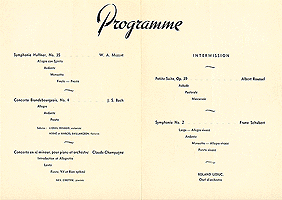 The Concerto was first performed by the Little Symphonies Orchestra (Canadian Broadcasting Corporation) conducted by Roland Leduc with Neil Chotem as soloist at the Hermitage Hall in Montréal, May 30, 1950. The Concerto was first performed by the Little Symphonies Orchestra (Canadian Broadcasting Corporation) conducted by Roland Leduc with Neil Chotem as soloist at the Hermitage Hall in Montréal, May 30, 1950.
 | Listen to an excerpt from Concerto in D minor. |
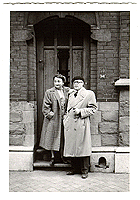 Claude Champagne and his wife Jeanne in Europe. Claude Champagne and his wife Jeanne in Europe.
[July 1952], photographer unknown.
The Quatuor à cordes (String Quartet) in C Major by Claude Champagne was composed between 1951 and 1954. It was performed for the first time on August 23, 1954, at the Hermitage Hall, by a quartet composed of Noël Brunet, Gilles Baillargeon, Lucien Robert and Walter Joachim. The concert was given under the auspices of Les Jeunesses Musicales du Canada and Montreal
Festivals. After this, the composer remodelled this work into its present form of two movements instead of the original three. The second version was premièred on December 11 by the Montreal Quartet during a concert of the Pro Musica Society at the Ritz-Carlton Hotel in Montréal.
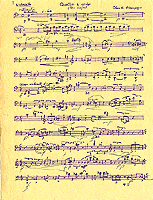 Cello part of the second version of the Quatuor à cordes. Autograph manuscript (stencil), n.d. Cello part of the second version of the Quatuor à cordes. Autograph manuscript (stencil), n.d. |
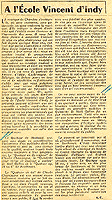 Review by Serge Garant of Claude Champagne's Quatuor à cordes. Notre temps (Montréal), December
8, 1956. Review by Serge Garant of Claude Champagne's Quatuor à cordes. Notre temps (Montréal), December
8, 1956. |
 | Listen to an excerpt from the Quatuor à cordes. |
In 1958, the members of the Canadian Arts Council commissioned the
composer to write "a great acoustic fresco for a symphony orchestra whose spirit will represent the unity and diversity that characterize our country."
Letter to Miss Jacqueline de Grandpré, June 26,
1958.
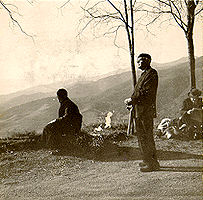 Claude Champagne (standing) in the East Pyrenees. Claude Champagne (standing) in the East Pyrenees.
[1959], photographer unknown.
 Claude Champagne at the time of Altitude. Claude Champagne at the time of Altitude.
[1959], photographer unknown.
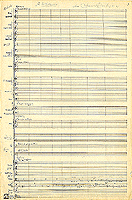 |
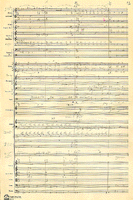 Pages from the full score for Altitude. Autograph manuscript, 1959. First performed on April 22,1960, in Toronto by the CBC Symphony Orchestra and Choir under the direction of Charles Houdret. Claude Champagne was the first Canadian composer to use the ondes Martenot (an electronic musical instrument invented by the Frenchman Maurice Martenot) in a major symphonic work.
Pages from the full score for Altitude. Autograph manuscript, 1959. First performed on April 22,1960, in Toronto by the CBC Symphony Orchestra and Choir under the direction of Charles Houdret. Claude Champagne was the first Canadian composer to use the ondes Martenot (an electronic musical instrument invented by the Frenchman Maurice Martenot) in a major symphonic work.
|
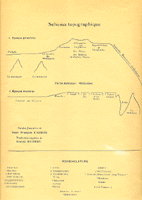 |
 Topographical scheme of Altitude. Topographical scheme of Altitude.
(1972-11/D2,5)
Reproduced with permission from Berandol Music Limited. |
 | Listen to an excerpt from Altitude. |
"... I wrote a symphony called Symphonie gaspésienne which expressed ... Canada's east, that is, the province of Quebec, and this work [Altitude] represents Canada's west, that is, the Rocky Mountains. And [these are] the impressions that I received ... upon seeing the Rocky Mountains, the mystery ... and all those things that impress you profoundly and [that] I took in unconsciously, filtered through my consciousness and expressed [themselves] through music.
... I see the first part as the expression of Canada's primitive life ... less refined ... in a language ... such as the language of the Huron ... I fused that to a centre that I call a meditation, in which you listen to ... all the acoustic sensibilities in nature, the calm, and I returned to the modern world with the words of St. Francis of Assisi ... and at the end I have echoes with the choirs ... which again give you the immense thing that dominates you."
Claude Champagne. Reception at the Délégation générale du Québec, in honour of Claude Champagne, following a concert at the Théatre
national du Palais de Chaillot à Paris, February 23, 1964. Société Radio-Canada, May 22, 1964, tape. (1972-11/J2,5).
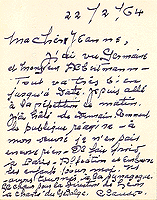 Note from Claude Champagne to Jeanne, his wife, February 22, 1964. Note from Claude Champagne to Jeanne, his wife, February 22, 1964. |
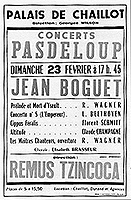 Poster for concert at which Claude Champagne's Altitude was performed in Paris, in 1964. Poster for concert at which Claude Champagne's Altitude was performed in Paris, in 1964. |
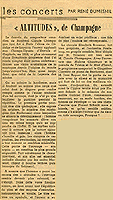 Article by René Dumesnil on Claude Champagne's Altitude. Le Monde (Paris), February 26, 1964, p. 14. Article by René Dumesnil on Claude Champagne's Altitude. Le Monde (Paris), February 26, 1964, p. 14.
 Note from Maurice Martenot, January 25, 1965. Note from Maurice Martenot, January 25, 1965.




|